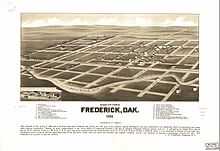Frederick, South Dakota
| Frederick, South Dakota | |
|---|---|
| City | |
 | |
| Coordinates: 45°49′58″N 98°30′25″W / 45.83278°N 98.50694°WCoordinates: 45°49′58″N 98°30′25″W / 45.83278°N 98.50694°W | |
| Country | United States |
| State | South Dakota |
| County | Brown |
| Incorporated | 1882[1] |
| Area[2] | |
| • Total | 0.39 sq mi (1.01 km2) |
| • Land | 0.39 sq mi (1.01 km2) |
| • Water | 0 sq mi (0 km2) |
| Elevation | 1,381 ft (421 m) |
| Population (2010)[3] | |
| • Total | 199 |
| • Estimate (2012[4]) | 200 |
| • Density | 510.3/sq mi (197.0/km2) |
| Time zone | Central (CST) (UTC-6) |
| • Summer (DST) | CDT (UTC-5) |
| ZIP code | 57441 |
| Area code(s) | 605 |
| FIPS code | 46-22860[5] |
| GNIS feature ID | 1255150[6] |
Frederick is a town in Brown County, South Dakota, United States. The population was 242 at the 2010 census. Home to the annual Frederick Finn Fest, the town is part of the Aberdeen Micropolitan Statistical Area.
History

Frederick was a railway town platted and sold to pioneers by the Chicago, Milwaukee & St. Paul Railroad, which completed track into it on September 12, 1881. Its grid of blocks was aligned by compass, with numbered avenues running north-south, and numbered streets running east-west. Main Street and Railway Avenue intersect at the grid's core. Incorporated on June 21, 1882, Frederick was named after the railroad's Finnish immigration agent and sales clerk—Kustaa "Frederick" Bergstadius.
Geography
Frederick is located at 45°49′58″N 98°30′25″W / 45.83278°N 98.50694°W (45.832812, -98.507026).[7]
According to the United States Census Bureau, the town has a total area of 0.39 square miles (1.01 km2), all of it land.[2] Frederick is drained by the Maple River.
The town is connected by ![]() U.S. Route 281.
U.S. Route 281.
Frederick has been assigned the ZIP code 57441 and the FIPS place code 22860.
Demographics
2010 census
As of the census[3] of 2010, there were 199 people, 101 households, and 56 families residing in the town. The population density was 510.3 inhabitants per square mile (197.0 /km2). There were 119 housing units at an average density of 305.1 per square mile (117.8 /km2). The racial makeup of the town was 98.5% White, 0.5% Asian, and 1.0% from two or more races.
There were 101 households of which 22.8% had children under the age of 18 living with them, 47.5% were married couples living together, 2.0% had a female householder with no husband present, 5.9% had a male householder with no wife present, and 44.6% were non-families. 41.6% of all households were made up of individuals and 18.8% had someone living alone who was 65 years of age or older. The average household size was 1.97 and the average family size was 2.66.
The median age in the town was 51.4 years. 19.6% of residents were under the age of 18; 2.4% were between the ages of 18 and 24; 21.5% were from 25 to 44; 29.1% were from 45 to 64; and 27.1% were 65 years of age or older. The gender makeup of the town was 55.3% male and 44.7% female.
2000 census
As of the census[5] of 2000, there were 255 people, 119 households, and 76 families residing in the town. The population density was 699.7 people per square mile (273.5/km²). There were 140 housing units at an average density of 384.2 per square mile (150.2/km²). The racial makeup of the town was 97.65% White, 1.18% Native American, 0.39% from other races, and 0.78% from two or more races. Hispanic or Latino of any race were 0.39% of the population. 45.2% were of German, 22.6% Norwegian and 7.5% Finnish ancestry according to Census 2000.
There were 119 households out of which 27.7% had children under the age of 18 living with them, 51.3% were married couples living together, 8.4% had a female householder with no husband present, and 35.3% were non-families. 33.6% of all households were made up of individuals and 19.3% had someone living alone who was 65 years of age or older. The average household size was 2.14 and the average family size was 2.69.
In the town the population was spread out with 22.7% under the age of 18, 5.9% from 18 to 24, 23.9% from 25 to 44, 25.1% from 45 to 64, and 22.4% who were 65 years of age or older. The median age was 42 years. For every 100 females there were 91.7 males. For every 100 females age 18 and over, there were 95.0 males.
The median income for a household in the town was $31,500, and the median income for a family was $34,688. Males had a median income of $25,288 versus $18,214 for females. The per capita income for the town was $13,881. About 11.1% of families and 11.4% of the population were below the poverty line, including 13.4% of those under the age of eighteen and 18.8% of those sixty five or over.
Notable resident
References
- ↑ "SD Towns". South Dakota State Historical Society. Retrieved 2010-02-12.
- ↑ 2.0 2.1 "US Gazetteer files 2010". United States Census Bureau. Retrieved 2012-06-21.
- ↑ 3.0 3.1 "American FactFinder". United States Census Bureau. Retrieved 2012-06-21.
- ↑ "Population Estimates". United States Census Bureau. Retrieved 2013-05-29.
- ↑ 5.0 5.1 "American FactFinder". United States Census Bureau. Retrieved 2008-01-31.
- ↑ "US Board on Geographic Names". United States Geological Survey. 2007-10-25. Retrieved 2008-01-31.
- ↑ "US Gazetteer files: 2010, 2000, and 1990". United States Census Bureau. 2011-02-12. Retrieved 2011-04-23.
Further reading
External links
- Town of Frederick, South Dakota
- Emma Burnham Public Library
- Frederick Area Historical Society
- Frederick Finn Fest
| ||||||||||||||||||||||||||
